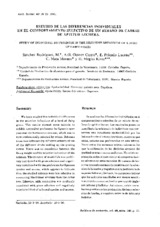Estudio de las diferencias individuales en el comportamiento selectivo de un rebaño de cabras de aptitud lechera
Study of individual differences in the selective behaviour of a herd of dairy goats
Autor
Gómez-Castro, A.G.
Mata Moreno, C.
Megías Rivas, M.D.
Peinado Lucena, E.
Sánchez Rodríguez, M.
Editor
Universidad de Córdoba, Servicio de PublicacionesFecha
1991Materia
Alimentación animalLeche
Apetecibilidad
Cabras
METS:
Mostrar el registro METSPREMIS:
Mostrar el registro PREMISMetadatos
Mostrar el registro completo del ítemResumen
We have studied the individual differences in the selective behaviour of a herd of dairy goats. The results showed some animals to exhibit a manifest preference for ligneous species over the herbaceous stratum, which was in turn preferentially selected by others. Between these two extremes lay different extends of use of the different strata making up the grazing ration. There was no correlation between the living weight and the selective behaviour of the animals. The number of mouthfuls was positively correlated with grass selection and negatively correlated with the preference for ligneous species and acorns, which appears to indicate that the studied animals were less selective in consuming the former stratum than the latter two. Likewise, milk production was positively correlated with grass selection and negatively correlated that of arboreal species and acorns. Se analizan las diferencias individuales en el comportamiento selectivo de un rebaño de cabras de aptitud láctea. Los resultados ponen de manifiesto la existencia de individuos que presentan una manifiesta apetecibilidad por las leñosas frente al estrato herbáceo, mientras que otros, centran sus preferencias en este último. Entre estos dos extremos existen cabras en las que la utilización de los distintos estratos del pastizal es más o menos uniforme. No existe correlación entre el peso vivo y el comportamiento selectivo de estos animales. El número de bocados presenta correlación positiva con la selección de la hierba y negativa con la preferencia de especies leñosas y bellotas, lo que parece indicar que los animales estudiados son menos selectivos cuando consumen hierba que cuando ingieren leñosas y bellotas. Así mismo, existe correlación positiva entre producción láctea y selección de hierba, y negativa entre la de árboles y bellotas.

